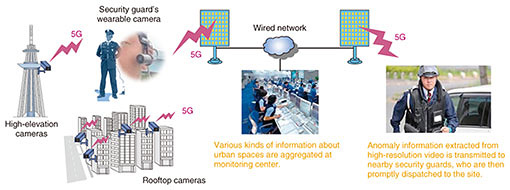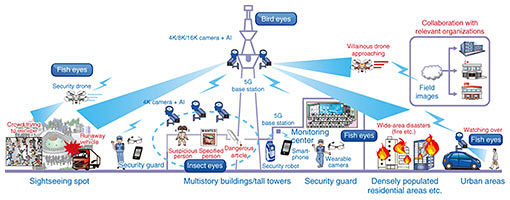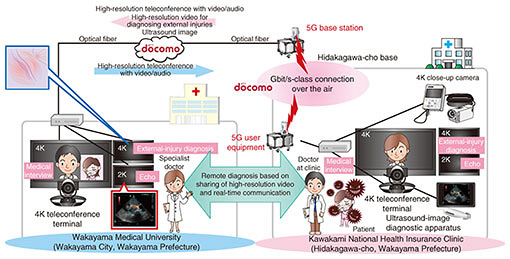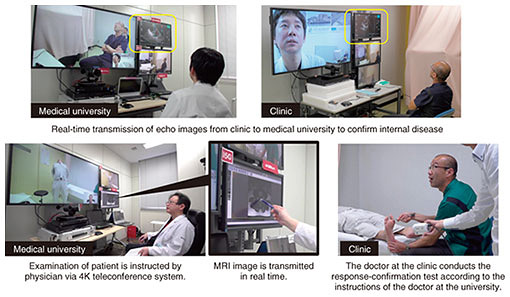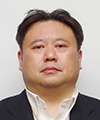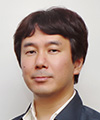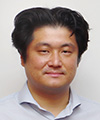 |
|
|
|
|
|
Feature Articles: 5G Field Trials toward Social Implementation Vol. 16, No. 10, pp. 47–53, Oct. 2018. https://doi.org/10.53829/ntr201810fa8 5G Field Trials in the Smart City and Medical Service Areas toward Social Implementation of 5GAbstractIn this article, we describe two examples of field trials contracted by the Ministry of Internal Affairs and Communications of Japan concerning application of fifth-generation mobile communications systems (5G). The first example was in the area of smart city/smart area and was focused on providing a safe and secure society. The results of experimental trials confirmed that the transmission and aggregation of high-resolution video to a monitoring center enabled facility monitoring and wide-area monitoring in places where many people gather such as public facilities and sports events. The second example was in the medical area and involved the provision of remote medical services. Video interviews conducted via a high-resolution television conference system and multiple high-resolution videos obtained for diagnosis were simultaneously transmitted between a general hospital in a city and a rural clinic. Keywords: 5G, security, medical care 1. IntroductionNTT DOCOMO was contracted by the Ministry of Internal Affairs and Communications as the main implementing entity for a fiscal year 2017 project to examine the technical specifications for fifth-generation mobile communications systems (5G) that can achieve a data communication speed exceeding 10 Gbit/s in densely populated areas (study group GI). This article introduces examples of experimental trials conducted in the areas of smart city/smart area and medical services. The organizations participating in the experimental trials in these application areas are listed in Table 1.
2. Experimental trial in smart city areaWith the aim of establishing the advanced security services required for smart cities, namely, services for addressing premeditated crimes (e.g., terrorism, random attacks, and child kidnappings) that cannot be prevented by existing deterrence measures alone, we carried out experimental trials on a new security model for detecting and predicting signs of crime by utilizing high-resolution images and artificial intelligence (AI) via 5G in cooperation with Sohgo Security Services Co., Ltd. and NEC Corporation (Fig. 1).
This initiative is based on the concept of modern-day fire watchtowers, with the ultimate goal being to achieve an urban-space security system that monitors an entire urban space by analyzing various camera images corresponding to the three eyes described below (Fig. 2).
(1) Insect eyes for detecting suspicious persons and people in trouble from camera images captured at facilities (2) Fish eyes for analyzing field video in real time from images captured by cameras worn by guards and attached to drones (3) Bird eyes for promptly detecting fire and damaged and/or impassable roads as well as vehicle attacks by terrorists from images captured by high-elevation cameras In fiscal year 2017, we carried out experimental trials on two monitoring services, namely, facility monitoring and wide-area monitoring.
2.1 Facility monitoring (insect eyes and fish eyes)At the National Museum of Emerging Science and Innovation (Tokyo) from November 9 to 11, 2017, we experimentally demonstrated a new in-facility security system utilizing high-resolution images captured by surveillance cameras and a face-authentication gate (Fig. 3). This demonstration featured the utilization of face-recognition and image-recognition technology based on AI and recognition of necessary information in real time from images captured by surveillance cameras to achieve primary security in a specific space.
We confirmed that increasing the video frame rate by utilizing the ultrahigh-speed and large-capacity communication of 5G made it possible to increase face-collation frequency by up to six times in comparison with that of a system assumed to utilize 4G that uses the same face-collation algorithm. This system is expected to easily enable the construction of a security area for events. Visitors evaluated the system favorably with comments such as “Although I normally feel nervous in places where security guards are concentrated, I didn’t experience that feeling at all with this new system.” Moreover, from February 13 to 16, 2018, in the vicinity of Yasukuni Avenue, Tokyo (Shinjuku Ward), we conducted an experimental trial on transmission of high-resolution video under the assumption that security guards will share security and warning information. We confirmed that even with 5G transmission, performance (throughput and response time) comparable to that achieved in an indoor test using a wired LAN (local area network) was obtained, and transmission was quicker and more stable than that of a conventional wireless transmission system. 2.2 Wide-area monitoring (bird eyes)Since March 15, 2018, we have been conducting experimental trials on wide-area monitoring using 4K high-resolution cameras installed on the Tembo Deck (340 m high) of Tokyo Skytree® and an AI processing server (Fig. 4). The final goal of this trial is to achieve high-precision monitoring and real-time information sharing by transmitting on-site video captured by wearable cameras worn by security guards and by surveillance cameras via 5G. The assumed use case was monitoring the observation area for fires and traffic accidents, and this trial verified the effectiveness of this technology for detecting anomalies.
In particular, we tested 720p video transmission by 4G and 2160p (4K) video transmission by 5G in order to evaluate the network bandwidth capacity. With image analysis by AI, for example, for detection of fires by using images captured from the Tembo Deck, recognition of vehicles traveling on expressways, and recognition of locations of traffic jams where traffic accidents are expected, this test confirmed that the ability to discriminate distant objects greatly depends on the resolution of the image and also confirmed that 5G is clearly superior in terms of that ability to distinguish distant objects. The large-capacity data communication made possible by 5G enables wide-area monitoring and thereby contributes to creating safe and secure cities. It is also expected to contribute to early detection and prevention of crimes and disasters and to reduce work flows for security operation. 3. Experimental trial in medical areaIn collaboration with Wakayama Prefecture and Wakayama Medical University, we conducted an experimental trial of advanced telemedicine services utilizing high-resolution video transmission via 5G (Fig. 5). The objective of this test was to evaluate the effectiveness of the video transmission system in medical consultations. The goal is to develop a system for providing advanced medical treatment equivalent to that available at urban general hospitals, in rural areas such as mountainous areas, and to eliminate medical disparities between urban and rural areas.
A large portion of Wakayama Prefecture is taken up by mountains, and in many areas, it takes a long time to get to a secondary medical institution. Large hospitals with more than 500 beds are only available in Wakayama City. The Regional Medical Support Center of Wakayama Medical University (Wakayama City, Wakayama Prefecture) has already introduced a remote medical support system that enables various kinds of support for remote medical institutions. This system connects remote medical institutions with the university via television conferences (teleconferences) using an Internet connection to support local medical care services throughout Wakayama Prefecture. However, in the case of rural clinics, where FTTH (fiber-to-the-home) services are not available, the xDSL (x digital subscriber line) service provided by cable television operators and 4G (LTE: Long-Term Evolution) services are the current means of Internet access, so the video quality of the teleconferences has been restricted. In this experimental trial, a network was configured connecting the Regional Medical Support Center of Wakayama Medical University and the neighborhood of the Kawakami National Health Insurance Clinic (Hidakagawa-cho, Wakayama Prefecture) by optical fiber and the last-mile communication to the clinic by using 5G. This test confirmed that through the ultrahigh-speed communication enabled by 5G, it was possible to correctly comprehend symptoms such as skin diseases by transmitting high-resolution video. It also confirmed that doctors at Wakayama Medical University and doctors at the Kawakami National Health Insurance Clinic can cooperate and smoothly diagnose patients while communicating via the high-resolution teleconference system. In concrete terms, as diagnostic equipment for the imaging system, a 4K high-resolution close-up camera (used for diagnosis of skin diseases and injuries as well as intraoral diagnosis), an ultrasound-image diagnostic apparatus (echo) (used for diagnosis of internal diseases etc.), and video output from an MRI (magnetic resonance imaging) device were set up in a manner enabling communication between the university and the clinic. In addition, a 4K high-resolution video conference system was implemented to enable doctors to exchange opinions and interview patients. In this experimental trial, which was conducted from February 20 to March 6, 2018, we utilized the framework of the remote outpatient service provided by Wakayama Prefectural Medical University to conduct examinations according to medical practice and a demonstration for media in a total of five cases (three cases of dermatology, one case of orthopedic surgery, and one case of cardiovascular internal medicine) (Fig. 6). Utilizing 5G made it possible to share high-resolution video, which requires a data rate over 100 times faster than past rates, between the two sites. Listed below are the impressions of doctors and patients who participated in this experimental trial.
Doctors’ impressions
Patients’ impressions
Through the above-described tests, we clarified that at actual remote medical practices, it was possible to achieve increased presence, improve the accuracy of diagnosis, and reduce medical treatment time by utilizing the high-resolution video transmission provided by 5G. As a result, these achievements helped to reduce the burden on doctors at the medical university and also helped patients access the highest quality medical care without having to undertake a long and inconvenient journey. We also confirmed that this 5G system contributes to raising the level of local medical care and nurturing young doctors at remote clinics. Trademark notes“Tokyo Skytree” is a registered trademark of Tobu Tower Skytree Co., Ltd. and Tobu Railway Co., Ltd. |


